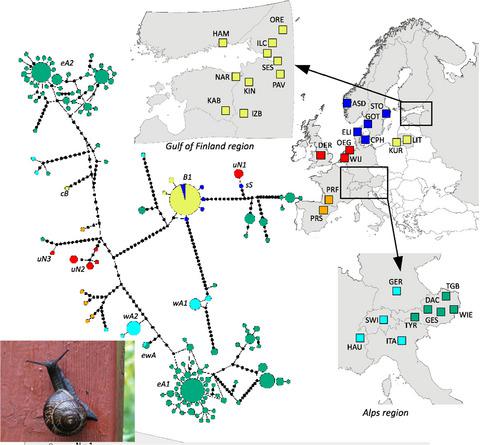当前位置:
X-MOL 学术
›
J. Zool. Syst. Evol. Res.
›
论文详情
Our official English website, www.x-mol.net, welcomes your
feedback! (Note: you will need to create a separate account there.)
Copse snail Arianta arbustorum (Linnaeus, 1758) (Gastropoda: Helicidae) in the Baltic Sea region: Invasion or range extension? Insights from phylogeographic analysis and climate niche modeling
Journal of Zoological Systematics and Evolutionary Research ( IF 2.0 ) Pub Date : 2020-01-28 , DOI: 10.1111/jzs.12350 Olga Bondareva 1 , Evgeny Genelt–Yanovskiy 1 , Natalia Abramson 1, 2
Journal of Zoological Systematics and Evolutionary Research ( IF 2.0 ) Pub Date : 2020-01-28 , DOI: 10.1111/jzs.12350 Olga Bondareva 1 , Evgeny Genelt–Yanovskiy 1 , Natalia Abramson 1, 2
Affiliation

|
The range of Arianta arbustorum is spreading eastwards across the Baltic Sea region. Because A. arbustorum is a common pest in agriculture and horticulture, understanding the origin and factors involved in the eastward range expansion of the land snail are important for future planning of species management. In the present study, we compared the genetic diversity of A. arbustorum in the recently established easternmost populations and across Europe using standard phylogeographic analyses on a mitochondrial marker (cytochrome c oxidase I). We also applied bioclimatic envelope modeling to determine the environmental factors responsible for the ongoing range shifts of A. arbustorum. The unique haplotype lineage was found in all Baltic Sea populations in contrast with the highly polymorphic populations from Central Europe and the Alps. The peripheral easternmost populations were fixed for the dominant haplotype of the Baltic lineage. Retrospective niche modeling confirmed previous assumptions of multiple glacial refugia of A. arbustorum in Europe. Our results also show that the emergence of new populations in the easternmost part of the A. arbustorum range and the presumptive loss of rear‐edge populations in western Europe are most plausibly caused by ongoing climate change, which will have a remarkable effect on the future distribution of genetic diversity within the range of the copse snail.
中文翻译:

在波罗的海地区的小蜗牛Arianta arbustorum(Linnaeus,1758年)(Gastropoda:Helicidae):入侵还是范围扩大?来自植物地理学分析和生态位建模的见解
Arianta arbustorum的范围在波罗的海地区向东扩展。由于丛枝农杆菌是农业和园艺业中的常见害虫,因此了解螺的向东扩展的起因和相关因素对于今后物种管理计划至关重要。在本研究中,我们使用线粒体标记(细胞色素C氧化酶I)的标准系统地理分析,比较了最近建立的最东部种群和整个欧洲的丛枝曲霉的遗传多样性。我们还应用了生物气候包络模型来确定造成正在进行的A. arbustorum范围变化的环境因素。 。与来自中欧和阿尔卑斯山的高度多态种群相反,在所有波罗的海种群中都发现了独特的单体型谱系。最外围的人口固定为波罗的海沿岸的优势单倍型。回顾性利基模型证实了以前在欧洲对A. arbustorum进行多次冰川消退的假设。我们的研究结果还表明,A。arbustorum范围的最东部出现了新种群,而西欧的后缘种群的推测性损失最有可能是持续的气候变化造成的,这将对未来产生显着影响在小蜗牛范围内的遗传多样性分布。
更新日期:2020-01-28
中文翻译:

在波罗的海地区的小蜗牛Arianta arbustorum(Linnaeus,1758年)(Gastropoda:Helicidae):入侵还是范围扩大?来自植物地理学分析和生态位建模的见解
Arianta arbustorum的范围在波罗的海地区向东扩展。由于丛枝农杆菌是农业和园艺业中的常见害虫,因此了解螺的向东扩展的起因和相关因素对于今后物种管理计划至关重要。在本研究中,我们使用线粒体标记(细胞色素C氧化酶I)的标准系统地理分析,比较了最近建立的最东部种群和整个欧洲的丛枝曲霉的遗传多样性。我们还应用了生物气候包络模型来确定造成正在进行的A. arbustorum范围变化的环境因素。 。与来自中欧和阿尔卑斯山的高度多态种群相反,在所有波罗的海种群中都发现了独特的单体型谱系。最外围的人口固定为波罗的海沿岸的优势单倍型。回顾性利基模型证实了以前在欧洲对A. arbustorum进行多次冰川消退的假设。我们的研究结果还表明,A。arbustorum范围的最东部出现了新种群,而西欧的后缘种群的推测性损失最有可能是持续的气候变化造成的,这将对未来产生显着影响在小蜗牛范围内的遗传多样性分布。











































 京公网安备 11010802027423号
京公网安备 11010802027423号